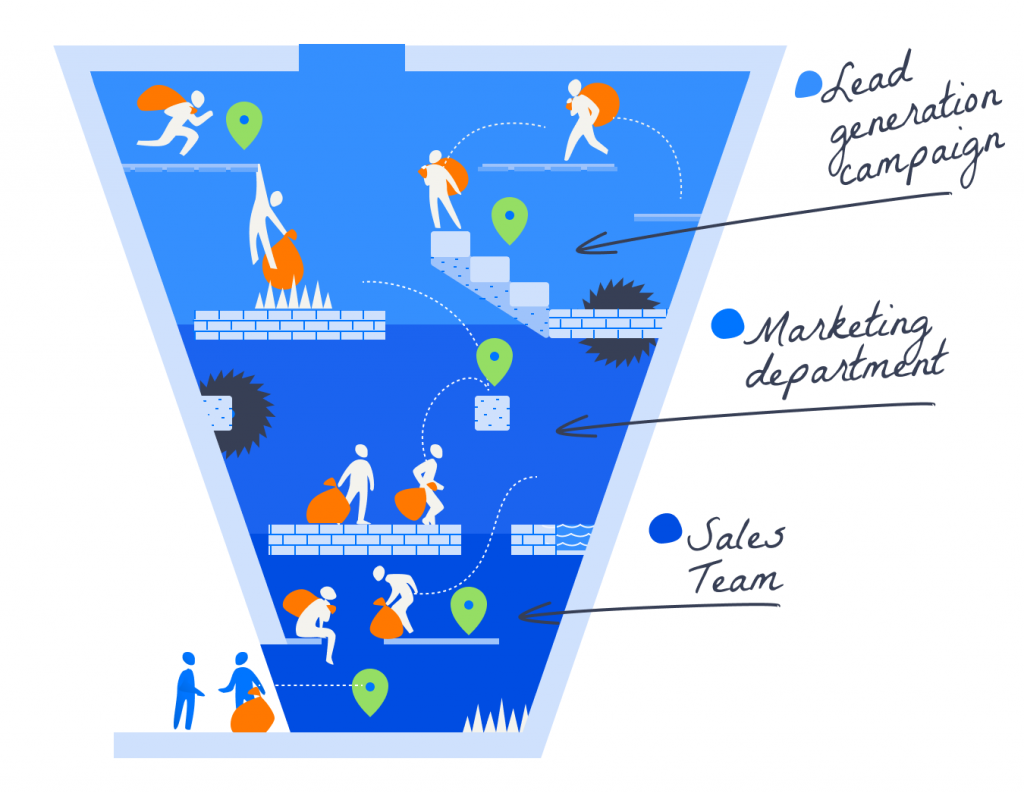Quality leads are one of the fastest ways to grow a successful business.
These leads are the pillar of a successful sales funnel. Qualified leads provide a steady flow of potential customers and have a higher chance of converting into actual sales. They save time and resources by not having to chase after uninterested or unqualified prospects.
But here’s the truth: 26 percent of marketers consider understanding lead quality their biggest challenge. Finding quality leads can be a nerve-wracking and time-consuming process and requires research, patience, and a little bit of luck.
What is lead quality?
Lead quality refers to how likely a consumer is to convert into a paying customer. You measure it by factors such as their interest level, fit within your target market, and financial ability to purchase. The lead qualification process involves analyzing and evaluating these factors to determine whether a lead is worth pursuing. Most organizations have a process where the marketing department passes on leads to the sales team after vetting them for quality.
When a prospect engages with your company through a lead generation campaign, for example, they have the potential to convert if you nurture them correctly. These are marketing-qualified leads (MQLs). The marketing department then evaluates their level of interest and assesses their ability to buy to determine if they qualify as sales-qualified leads (SQLs). After this, the leads are passed on to the sales team, who close the deal.
Why is lead quality important?
There are several reasons why lead quality matters. It helps you:
Evaluate channel performance
Every marketing channel has its strengths and weaknesses, and the effectiveness of each channel varies depending on the target audience. A jewellery business, for example, may find that using paid search ads on Instagram has a higher conversion rate than the same ads on Facebook. Similarly, a B2B MarTech company may find that its target audience is more likely to convert with cold emails than direct mail.
If you understand which channels give you high quality leads, you can invest more in those channels and cut back on the ones that bring you a lot of leads but of poor quality. This will help you maximize your marketing budget and improve your ROI. It’s also crucial to differentiate between channels that generate demand and those that capture it.
Some channels, such as paid search, may drive initial traffic to your website but don’t do much for turning site visitors into actual customers. Other channels, like email marketing, may not generate traffic but do a great job of converting leads into customers. A combination of both helps maximize your lead generation efforts.
Set realistic sales goals and forecast
Sales goals and projections help you measure and plan for success, but they can only be accurate if you adjust the quality of leads. While bad leads do convert, they do so at a lower rate than high-quality leads. Enough high-quality leads ensure your sales goals and forecasts are accurate and realistic and lead to better planning and success in the long run.
Better lead quality lets you calculate how many potential customers you can realistically expect to close deals with and optimize your sales funnel accordingly. You can also use it to set expectations with your sales team, giving them enough time and resources to close deals without feeling pressured. This can help increase both their productivity and your company’s revenue.
Save time and resources
Quality leads are more likely to engage with your outreach and move through the sales funnel, resulting in a higher close rate and faster sales cycle. You can then prioritize these leads and spend less time chasing after unqualified prospects.
For example, if your target market is millennials in the healthcare industry, you may find that the best leads come from LinkedIn and Twitter. This means you can focus more on creating content and campaigns tailored to these channels, increasing your chances of converting high-quality leads. It also means that you can focus less on channels that are not as effective for your target market, saving time and resources.

How to set up a lead scoring system
16 percent of marketing professionals consider lead scoring the most essential strategic element of a successful lead nurturing program. Lead scoring helps prioritize leads by assigning them a numerical value based on their profile and behavior. Here’s how to set up a lead-scoring system:
Evaluate historical data
Dive into your contacts database and analyze the data you already have on hand. See who became customers in the past and learn what they had in common, such as industry, job title, and buying persona.
Also, look at the attributes of leads who didn’t convert and figure out what they had in common. Once you have a good sense of your target customers, you can set up a scoring system that prioritizes their needs and behaviors.
Identify a valuable lead indicator
Lead indicators are the actions and behaviors that signal a lead’s potential to become a customer. Events such as visiting your pricing page, downloading a whitepaper or making an inquiry through your contact form are all valuable indicators. Set up a rule-based pattern for each indicator and assign a numerical value. For example, a real estate marketing site may assign a value of 10 to leads who visited the mortgage calculator and area map, while a B2B MarTech company may assign a value of 20 to leads who signed up for their product demo.
With this information, you can create a complete customer journey map that shows all the different touchpoints and actions a lead may take before purchasing your product or service. Assign values to these touchpoints and collaborate with your sales team to determine how much these actions are worth in terms of closed deals and revenue. Once you have an idea of how many leads will convert into customers, you can set realistic sales goals for your marketing team and forecast more accurately.
Identify decision-makers
The B2B sales process is typically more complex than the B2C one, so it’s important to gauge which decision-makers in your target market have the power to make purchasing decisions. While it may be tempting to target CMOs and CEOs, decision-making power and authority often lie in other individuals.
The process typically involves six to ten people, so it’s important to identify the key players who can approve or veto a purchase. These may include sales engineers, research and development executives, product managers, and technical support staff. Include these individuals in your lead scoring system based on their influence and buying power in the organization.
Set thresholds
Achieving a score above a certain threshold could show that the lead is ready for sales outreach. Thresholds ensure that you’re not wasting marketing resources on unqualified leads and focusing your attention only on those who are most likely to become customers.
This may include assigning a score of 70 or 80 points in exchange for a demo request, or setting a “hot” threshold to indicate when the lead is ready for sales outreach. Define cold, warm, and hot lead thresholds as a guide for sales teams and adjust based on performance. For example, you may consider a lead above 50 warm, while a score above 75 may show a hot lead ready for immediate follow-up. Use these thresholds as a guideline for prioritizing leads, and adjust them over time as you gather more feedback from sales.
Sources to help you identify a “good” lead
Should you talk to your existing customers, see what your sales team wants, or analyze what the data is telling you? The answer is usually a combination of all three.
Sales team
Sales reps are in direct contact with customers and have a deep understanding of their needs. These reps know which marketing collateral, offers, or campaigns generate the most conversions and can provide valuable feedback on the quality of your leads. Find out what reps share with prospects in their initial conversations and interactions, and use this information to help you identify high-quality leads.
Customers
Get in touch with people who actually bought your product or service and ask them what convinced them to make the purchase. Sales reps and customers are two sides of the same coin. Understand how the sales process works for your customers.
Conduct customer interviews to understand how they felt about the sales process and what led them to buy from you. Include customers with long and short sales cycles to see what factors led to quicker or slower conversions.
Data
Analyze attribution data to see which content, such as ebooks or whitepapers, leads download before becoming customers. If historically, the data shows that buyers who download your ebooks are more likely to buy from you, then it’s safe to assume that the quality of leads is high.
Also, find out which activities have resulted in the most contacts. Certain lead gen forms, such as webinars or ebooks, may generate more leads at a lower cost than other forms. Assign scores based on the conversion rates for these activities to identify your most successful marketing efforts.
Start generating better leads
Lead qualification is a comprehensive process that requires careful planning and implementation.
Every business should focus. on generating quality leads more likely to convert into customers – through targeted marketing campaigns, networking events, or lead scoring methods.
Advanced tools like Tomi.ai can use first-party behavioral data and machine learning to predict future sales and customer lifetime value. A focus on the best, most qualified leads will save time and resources for sales teams, leading to increased revenue and success for your business.
Don’t let valuable leads slip through the cracks – start qualifying today!



